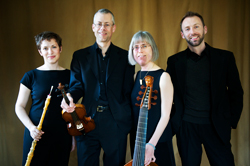by Nicholas Jones

French Baroque opera, now generally seen as recherché to the extreme, was once so popular that its tunes were madly sought after. As every garage band today wants to cover Justin Bieber, so many in the mid-eighteenth century wanted a bit of Rameau, even if they couldn’t be at the court of the Sun King.
Following their lead, Les Délices, Cleveland’s inventive and efficient baroque group showed us how opera could fit in the pocket. (But…did they have pockets then? Well, never mind!
The program gave us a taste of opera without singers and with vastly reduced forces —two violins to the famous 24 of the king’s band, a flute, an oboe, and basso continuo. This, we gather, is how the opera tunes may have trickled down to the masses in the ancien regime.
Rameau’s music was originally designed for big effects in big halls, for big, important folk. But reducing it, as music director and oboist Debra Nagy did for these concerts, brings out its complexity, if diminishing its volume. The spareness concentrated the ear on the intricate emotionalism that makes Rameau a master.
The evening was designed around six aspects of an opera, without pretending to tell a continuous story. First, of course, an overture, French in style, with dramatically fierce double-dotted rhythms that, we learned, evoked the evil magician in Rameau’s Zoroastre.
Next, divertissements, beloved of French opera, for example the lovely slow cascades marking an entrance of the Muse Polyhymnia (who knows why she entered, but when the Muse appears, we should all be glad!)
Then, from yet another opera (Hippolyte et Aricie) — dark matter, tragic and stormy: a sea-storm with swirling scales in the strings, and a pre-Hitchcock “Psycho-moment.”
An episode of more tender feelings followed, this one from an eighteenth-century adaptation of Rameau’s Castor et Pollux for two virtuouso viols — proving that Nagy was not the first to adapt these operas for rather smaller ensembles.
No French opera would be complete without “exotica,” here represented by selections from Rameau’s opera-ballet Les Indes Gallantes, including an Inca earthquake, a dance of African slaves, and the well-known dance “Les Sauvages” — the baroque’s attempt at representing American Indians. Charming music, if politically incorrect.
The “opera” closed, as all French operas did, with dances, a chaconne and a wild tambourin, from Dardanus.
So we got, in a little over an hour, parts of six Rameau operas! In place of a full orchestra, cast, and perspective set, we got virtuoso performances by seven players in an intimate setting, graced by lovely acrylics by Cleveland painter Tim Corrigan, thanks to patron Bill Busta.
The substitution of small forces for large entailed no loss because of the sure programming touch of the director and the stunning playing of each musician. Nagy brought her usual spark to the oboe lines, supported by Kathie Stewart on traverso. Playing at low baroque pitch (A=392, a whole tone below normal), the flute and oboe seemed to reinforce each other’s harmonics as if there was a third woodwind in the room.
The violin parts were played with flair and nuance by Scott Metcalfe and Julie Andrijeski. Michael Sponseller’s keyboard playing was essential to keeping the ensemble together: if reduced in numbers, this music was far from simplified, and it takes a strong harpsichord player to hold its complexities in order.
Finally, I must credit the wonderful pair of gamba players, Emily Walhout and Doug Kelley. Their expert playing both grounded the sound in an unusually strong bass line and sparked the liveliness that characterized the evening in general.
Published on ClevelandClassical.com November 13, 2012
Click here for a printable version of this article.


